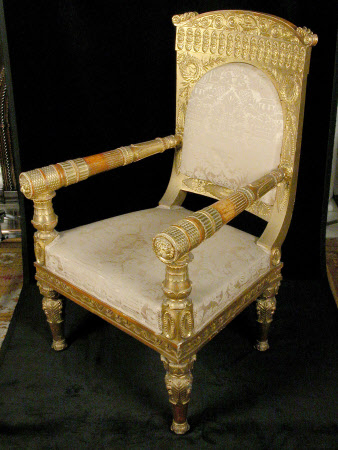Open armchair
probably Giocondo Albertolli (1742 - 1839)
Category
Furniture
Date
circa 1814
Materials
Carved and gilded walnut, silk
Measurements
110 x 68 x 72 cm
Place of origin
Genoa
Order this imageCollection
Attingham Park, Shropshire
NT 608173
Summary
A carved and gilded walnut open armchair, probably Genoa, circa 1814, related to designs by Giocondo Albertolli (1742-1839), covered with cream and gold silk (NT 609592 or ATT/T/071). Having a curved and pedimented toprail terminating in leafy volutes above a run of upright oblong flowerheads. The back fitted with a round-arched, padded and upholstered panel, between tightly-carved laurel wreath spandrels. The arms tubular, lappet-carved and fitted with a series of gilt, carved collars, terminating in lion masks and raised on vase-form supports on blocks with concave paterae. The seat upholstered and in seat rails carved with a run of Vitruvian scrolls, reversing at the centre and incorporating buds of acanthus. Raised on four turned, tapering and leaf-clasped legs.
Full description
This armchair was almost certainly acquired by William Noel-Hill, 3rd Baron Berwick (1773-1842), while ambassador to Italy. He represented George III at the exiled royal court of Sardinia at Cagliari, then in Turin, and finally Naples. He returned to Attingham with a large collection of Italian furniture. Four pieces in this collection - this armchair and a sofa, and a daybed and its accompanying armchair - are believed to be contemporary with each other, and to have been made in Genoa around 1814, after (or influenced by) the designs by Giocondo Albertolli (1742-1839). The other white-painted and gilded Italian furniture at Attingham is now thought to date from the 1820s and to have been designed by Carlo Randoni (1755-1831). For many years the daybed’s cipher has been misread as CM rather than MT (the French and Italian 'T' resembling an English 'C') and was therefore thought to be connected to Napoleon’s sister, Princess Caroline Murat (1782-1839), rather than the more likely previous owner, Queen Maria Teresa of Sardinia (1773-1832). Berwick was ambassador to the court of Maria Teresa and her husband King Vittorio Emanuele I of Sardinia (1759-1824) from 1807 to 1824. This armchair, Egyptian in style, has tubular arms resembling those of the sofa, and shares the Vitruvian scroll-carved seat rails - derived from plates IX and X(F) in Albertolli's Ornamenti Diversi (1782) - with the daybed and its matching armchair. The 3rd Baron Berwick may have acquired this armchair around 1824, when Maria Teresa moved from Turin to Genoa, but it is possible that she took this armchair (and the sofa, the daybed and its matching armchair) with her to furnish her new home. If this is the case, then he may have acquired this furniture after her death in 1832 and before his return to England – via Genoa – in 1833. The chair has been re-covered in cream and gold silk.
Provenance
3rd Lord Berwick collection: William Noel-Hill, 3rd Baron Berwick (1773-1842). Acquired by the 3rd Lord Berwick, who had been in Italy as British envoy and ambassador to the Kingdom of Naples and the Two Sicilies. By descent bequeathed to the National Trust with the estate, house and contents of Attingham by Thomas Henry Noel-Hill, 8th Baron Berwick (1877-1947) on 15th May 1953.
Makers and roles
probably Giocondo Albertolli (1742 - 1839), designer
References
Rowell & Burchard 2020: Christopher Rowell & Wolf Burchard, 'Italian Furniture at Attingham Park', Furniture History LVI (2020), 107-176, 118-9, Figure 16 Drury, 1984: Martin Drury. “Italian furniture in National Trust houses.” Furniture History, vol. XX, 1984., pp. 38-44; p. 42
